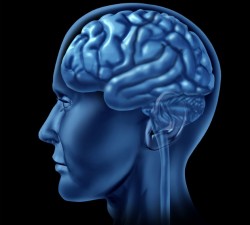Gadfly | May 13th, 2015

When 1976 Olympic decathlon champion Bruce Jenner, a real hunk of a muscular man, came out 39 years later with the statement “for all intents and purposes, I am a woman” in a rather spectacular TV interview, he also emphasized the mysteries of the brain. Jenner admitted his brain is more female than it is male. Why? Is it because of a wound? Is Satan playing games? Is it because of messed-up neurons and bad electrical connections? We don’t have a clue—yet. He was just a very young boy when he discovered he was more comfortable in his mother’s and sister’s dresses. Jenner says: “It just made me feel good.” He actually began transgender reassignment therapy in the 1980’s which included hormones, nose surgery, and hair removal. He then changed his mind.
We are just beginning to solve the great mysteries of the brain. It’s a very complex maze. There are 20,000 to 25,000 genes in the human genome and about half of them work in our brain “system,” whatever that is. Our famous upright ancestor Lucy of about 3.2 million years ago had a brain of 600 cubic centimeters. The next “human” (Homo Habilis) had 900 cubic centimeters to work with. Our current brother Homo Sapiens has a magnificent 1,400 cubic centimeters in order to tangle with the universe. The brain seems to be a very flexible conglomeration of electrical switches and breakers. Our billions of brain cells somehow communicate with all parts of the body, if things are working right, so that the actions of the body are almost robotic. But looking around our world we can see what happens if the switches and breakers don’t bring on or interrupt power.
In 1891 Italian Doctor Cesare Lombroso started to look at the brain in his book Man of Genius when he explored the traits of genius: left-handedness, celibacy, stammering, precocity, neurosis and psychosis. According the good doctor I’m definitely not a genius. Although I’m left-handed, I have never stammered as a youngster or while violating the laws of celibacy. Neither was I a precocious kid with various neuroses and psychoses. He thought these old guys were creative geniuses: Jean Jacques Rousseau, Isaac Newton, Arthur Schopenauer, Jonathon Swift, Charles Darwin, Lord Byron, and Robert Schumann. Darwin’s cousin Francis Galton entered the brain fray by naming 20 prominent musicians, including the Bachs and Beethoven, and many writers as geniuses. He forgot one. Mozart in his teen years wrote 30 symphonies, three operas, two long masses, 14 string quartets, 10 piano sonatas, and eight concertos—besides having teenage fun. Some geniuses are very susceptible to suicide for some reason: Vincent Van Gogh, Virginia Wolf, Ernest Hemingway, Hart Crane, Anne Sexton, and John Berryman to name a few. They were all real messes.
Every time 1st Viscount and Admiral Horatio Nelson, hero of the British fleet at Trafalgar and other trouble spots of the early 19th Century, stepped aboard ships he suffered from seasickness. He first experienced it at age 13 when he served as cabin boy -- and every day of 30 years at sea. I had a friend Lt. Ryder in the Marine Corps like that. Even when a ship was still tied to a dock he went immediately to his bunk for the length of the voyage. He was never cured. Nelson lost one eye in battle, and suffered from malaria most of his life, which gave him recurrent fevers, headaches and tremors. He often had difficulty holding a wine glass. He also lost his right arm to a sniper and was left a left-hander so he had to learn to write, dress, and eat with utensils all over again. When on land, which was not often, he carried pockets filled with oak acorns which he planted in uniform patterns in his garden. He wanted to make sure the English fleet never ran out of tall trees for barrels and masts for their tall ships. Admiral Nelson was killed at the battle of Trafalgar by a bullet through his spine. Ironically, his body was preserved and shipped back to England for “proper” burial in a brandy-filled oak barrel. It was placed by the oak mainmast of a ship and closely guarded. His brain had exhibited great flexibility in recovering from his wounds and compensating for them.
I see Minnesota is having online problems in testing the brains of our young students. Now maybe schools will actually teach something students can use instead of testing to see what they don’t know. We don’t know enough about the brain yet to discover how the electrical connections work. We have no idea how a soldier with a brain injured in Afghanistan woke up with a remarkable ability to learn languages. He is now fluent in dozens and is conversant in 93. How did the brain do that? An English woman has a stroke and wakes up with a French accent, a language she does not speak. A concert pianist is practicing a Beethoven sonata while watching her four-year-old son. When she goes to the kitchen for a break to prepare a cup of tea, she hears the sonata being played on her piano flawlessly. She runs to the piano, discovering her handicapped son is playing the piano -- for the first time. How did he do that? We have savants who can’t tie their shoe strings, brush their teeth, or dress themselves -- but can memorize big city phone books. We have had a savant who could read one page with one eye and the other page with the other eye at the same time and then assimilate the information. The really strange part is he can do the same thing with the book upside down. A surgical pathologist who specializes in brain diseases describes the brain thus: “Envision your brain, it’s billions of impulsive neurons, tendrils entwined, connected up in electrical circuits, elaborate glial scaffolds shoring up these circuits, like electrical tape. In the synapses, fluid filled clefts that separate neurons from one another, electrical impulses convert to chemical ones. Brain chemicals seep through the cleft fluid, bridging it with a flow of molecules. Thus do we smile, or weep, plumb the ocean or fiddle a tune.” When asked how savants accomplish their mysterious tasks, he said: “I don’t have a clue.”
Dr. Santiago y Cajal, the so-called father of brain science, goes rhapsodical-poetical in describing the brain: “nerve cells are the mysterious butterflies of the soul, the beatings of whose wings may some day—who knows—clarify the secret of mental life.” So Yano was the youngest freshman at the University of Chicago at 10. He played the piano at three, learned German at five, wrote poetry at six, and graduated from high school at nine. He loved classical music and hated heavy metal. A kid after my own heart. I wonder what happened to him … We still have no idea why Albert Einstein was classified mentally retarded or why Winston Churchill flunked grammar school. Einstein’s brain has been studied since it was removed during an autopsy. It’s just like everybody else’s. Thomas Edison had only three months of formal schooling and was thrown out of elementary school. He ended up holding 1,033 patents. And George Westinghouse was called a dunce by his teachers. George did OK later. We still don’t know what is important in education. Research says over one-half of the PhDs who graduate from our finest and “best” universities are in the bottom half of their high school classes. Is money the secret ingredient?
Every time we “goo” over a baby we should think that here is one of life’s great miracles. How does a suckling baby advance to a walking, talking toddler who doesn’t want to go to bed—at three years? An article by Yudhijit Bhattacharjee in the January issue of The Atlantic explores this phenomenon in “The First Year.” A paragraph summarizes the case: “Peering inside children’s brains with new imaging tools, scientists are untangling the mystery of how a child goes from being barely able to see when just born to being able to talk, ride a tricycle, draw, and invent an imaginary friend at age five. The more scientists find out about how children acquire the capacity for language, numbers, and emotional understanding during this period, the more they realize that the baby brain is an incredible learning machine. Its future—to a great extent—is on our hands.” The great French 17th Century mathematician Blaise Pascal invented the mechanical calculator when a teenager and his life’s work still influences math, physics, engineering and medicine. How is that possible?
A 2010 Philadelphia study discovered that childhood experiences shape the structure of the developing brain. And it proved another major point: there is a very positive link between a baby’s socio-economic status and the growth of brain cells and neurons. Babies come from the chute prewired. Upon birth, they immediately know “stuff.” But it’s the total environmental input that “wires” brains from that point on. Researchers studying IQs of children ages four and eight in the 1980s visited homes, checked the economic situation, and checked to see if the home had 10 children’s books, a children’s record player with songs and stories on the records, and toys that helped children learn letters, words and numbers. They also noted how parents spoke to children—and how they did it. Did the parents answer questions? Did they hug and kiss the children? If and when did they praise their children? The researchers found that children who had books, records, and toys and who were cuddled, praised, and stimulated by parents in the home had much higher IQs. When these children were in their teens they were checked by MRIs. The study proved that major brain growth came before the age of four—and not much between four and eight.
According to a new study by the Saban Research Institute at Children’s Hospital in Los Angeles, money can buy larger and more efficient brains. The better the economic situation of parents, the larger the surface area of their children’s brains. Elizabeth Sowell, the neuroscientist who developed the study, puts it bluntly: “Money can buy better education, homes in areas farther away from freeways. It can buy guitar lessons. It can buy after-school programs; it can buy better health care, better nutrition. It’s all of those things that money can buy that lead to more enriched experiences for children in wealthier families. We’ve known for a long time that cognitive development, school performance and productivity in adult life can be impacted by socioeconomic status, but now we’re actually seeing it in the brain.” (Geez, after 58 years spent in schools, I would have told them that for nothing.) Another study indicated that poor children born and living in polluted areas have shrunken “white matter” areas of the brain which is caused by vehicle exhaust, power plant emissions, secondhand cigarette smoke, and even prenatal exposure to polycyclic aromatic hydrocarbons.
Minnesota Governor Mark Dayton wants to fully fund full-time preschool programs for all Minnesota children. We need to provide many experiences to develop children’s brains. All of this research supports his position. Republicans, who seem to be traumatized by gays, guns, voting IDs, and tax increases, are opposed to full funding. So what else is new? By the way, dads, fathers who spend time sharing the tasks of raising children with the mother end up adding brain cells that will equal the number in the mother’s brain. That’s why we say “Holy Cow!” instead of “Holy Bull!”
July 7th 2025
July 1st 2025
June 24th 2025
June 19th 2025
June 9th 2025
_(1)__293px-wide.jpg)



__293px-wide.jpg)
__293px-wide.jpg)